Nancy Lu Rosenheim is a multifaceted traveling spirit. Having lived and worked in various locals, Rosenheim cross-pollinates life experience and a fascination with the evident conflict between human evolution and our environment. Last month, the COMP Magazine visited Rosenheim’s Rogers Park studio to discuss her many travels, the experimental gallery, The Bike Room, the nature of her production, and the installation Swallow City: Pods and Ta Prahm Trees exhibited earlier this year at the Hyde Park Art Center.
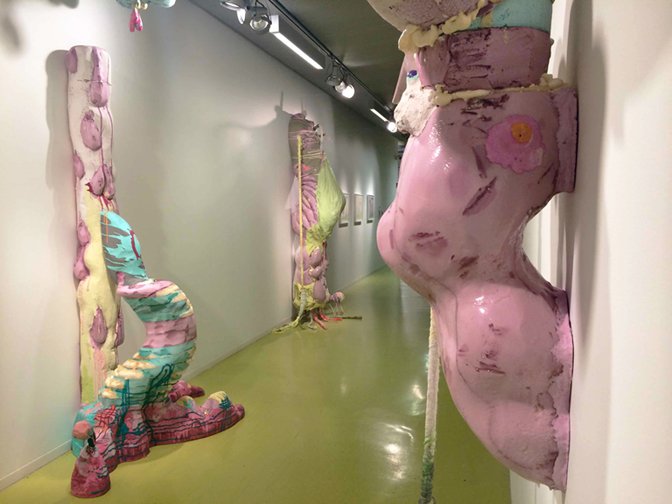
Nancy Lu Rosenheim
Epiphyte Capital, Sweating Thitpok, Thitpok with Lianas and Arched Back
, 2015
Polystyrene, epoxy resin, mixed media, 72”x38”x27”
Photo credit: Paul R. Solomon
You have a rather colorful background. You were raised in Highland Park, Illinois, studied in New York and Paris, lived in Granada, Spain, and returned to Chicago. How did these varied locations inform your current artistic practice?
The influence of my prodigious German-Jewish clan is probably Highland Park’s only contribution to my practice. I grew up amongst so many relatives that in high school, most people I met turned out to be my cousins. That North Shore suburb was infested with Rosenheims, Uhlmanns, Leopolds, Loebs (yes, truly), Newmans, Goldstines and Greenebaums. The phenomenon of Chicago’s assimilated German-Jewish community is the stuff of several books, a subculture to be reckoned with. I have mused over whether my brand of imagism (Chicago) and nod to the grotesque (German) was informed by my ethnicity.
New York City, my home for eleven years, supplied the internationality and cultural hodgepodge that would define my tribe forever. But NY, NY informs everyone’s practice, whatever his/her excuse. New York is our education; it’s where we learn to be artists.
Reference to Spain’s ecclesiastical iconography still lingers in my use of gold leaf and carved, stoic figurines. My inclination toward abject materiality was inspired by the earthy masonry of the Albaicín, my seven-year neighborhood in Granada. The day I whitewashed my studio, a small room and patio in a 12th century building, is the day I became a sculptor, though I wouldn’t know it until 15 years later. The caldero delivered two mule-loads of cal viva (limestone) to my door. The transformation of those grey rocks into pristine liquid chalk is a miracle I will never forget. I can still taste the calcium whiteness of it.
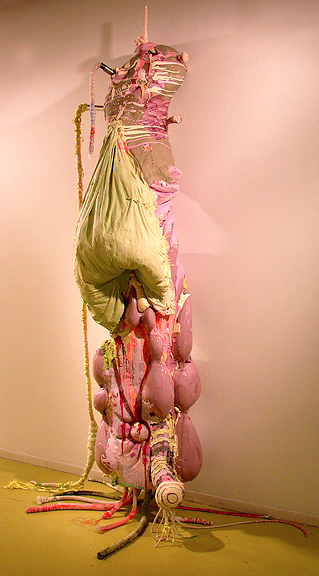
Nancy Lu Rosenheim
Thitpok with Lianas and Arched Back
, 2015
Polystyrene, epoxy resin and mixed media, 120”x39”x31”
You’ve run The Bike Room for some time. This is a curiously alternative exhibition venue located in a basement (former bike room?) in Rogers Park. What was the impetus for this effort? Was there a specific mission you defined for the space that informed the type of work you presented?
There’s a Peanuts comic strip in which Lucy sets up a doctor’s booth in order to be “on the right side of the needle”. The Bike Room is my platform to experiment with the notion of career and community building from the giving perspective. I can be audacious in promoting works of others, of artists I greatly admire, while my own art ego is out of the equation.
As for the space itself, I have always looked at raw interiors and dreamed projects into them. For example, in the 1980s I transformed a shoe factory into a loft in Williamsburg, Brooklyn. We were only a handful of artists back then, living in defunct buildings. Ditto this experience in Granada. Ditto in Chicago. The Bike Room is my curatorial playground, grown from the ashes of my condo building’s bike dump. Before that, it had been used to store coal for the old boiler. I almost called it The Coal Room, but that name was too romantic.
I curate artists very different from myself. My practice is maximal, flamboyant and labor-intensive, while the artists I work with are minimal, cerebral and conceptual more often than not. I love the process of providing a new architectural context to the life trajectory of an artist’s brainchild. It is breathtaking to see how projects interact with TBR’s space. I actually think that my curatorial mischief informed my decision to work in quirky spaces like the stairwell installation at HPAC.
Mission statement: The Bike Room is a project space committed to providing artists a platform to audition new strategies and deviate from their established practice. Its subterranean chameleon spaces inspire site-specificity. TBR’s homegrown openings facilitate the bringing together of diverse communities.
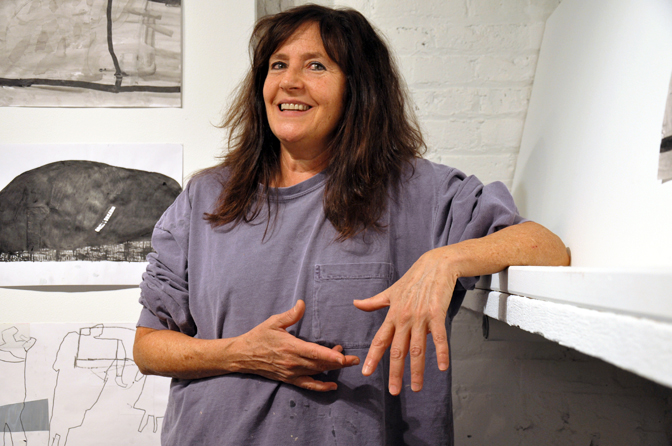
Nancy Lu Rosenheim at The Bike Room with The Shetland Drawings by Fraser Taylor, Chicago, IL 2015
Photo credit: Chester Alamo-Costello
What do you value in the art-making process?
1. The honesty
2. The handiwork, craftsmanship and physical action of making
3. The intellectual workout
4. The solitude and quiet
5. Oh – and I really love rendering, that magical process of creating illusion.
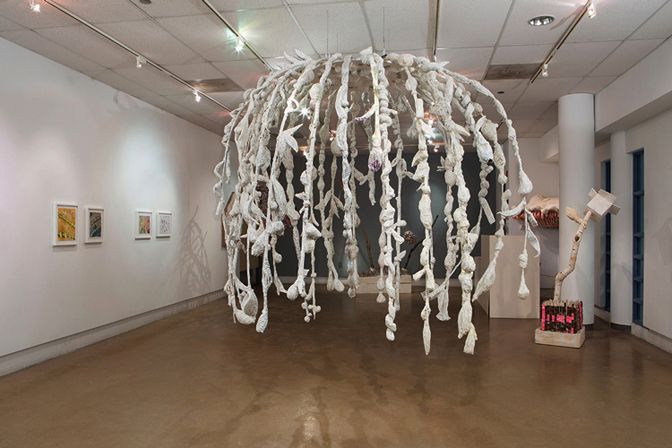
Nancy Lu Rosenheim
Weeping Willow
9’x9’x9’, 2013
Mixed media
Photo credit: Clare Britt
You’ve worked in varied styles during your tenure of production. At times, I see distinct narrative visual elements, organic abstraction, and a merging of the two. Is there an ongoing investigation that ties these efforts together?
All of my work is narrative with varying degrees of representation. Sometimes the methods are literal – even illustrative. (I teach Illustration as a day job.)
My drawings and paintings rely more heavily on representation; they are the sketchpad for my sculpture. The sculptures are more about form and texture. Even so, there is always an underlying tale to tell. The Thitpok sculptures from Swallow City seem so realistic to me that I fear my metaphors are too blatant! But I concede that, to the viewer, they are abstractions. I endowed Thitpok with Arched Back with the carnal attributes I see in trees: wrinkles around a folded limb, cancers growing out of orifices, etc. From an earlier project, Carnal Animates, the forms of a dancer’s legs wearing pink tights informed the representation of spewing streams of smoke. Was the outcome too obvious? I prefer that the viewer bring his/her own associations to play, prompted by my contextual hints. Usually only my mother finds the exact hidden allusions.
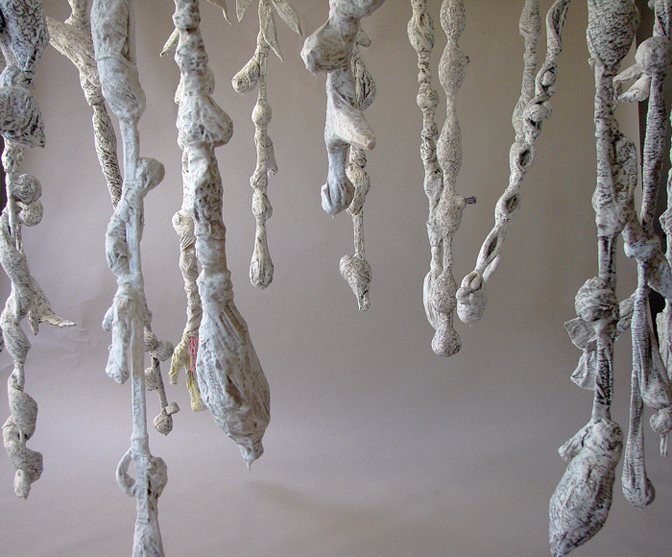
Nancy Lu Rosenheim
Weeping Willow (detail)
9’x9’x9’, 2013
Mixed media
Photo credit: Clare Britt
You produced a mixed-media installation, Swallow City, at the Hyde Park Art Center earlier this year. This work is described as “pointing to the underlying tension between nature and humanity with nature’s ultimate ability to overpower and repurpose built spaces.” What prompted you to produce this project? Will this be a topic you intend to further investigate?
I am a nature monger. Much of my childhood was spent in the woodlands of Wisconsin, in a geological anomaly called the Driftless Area. I am mesmerized by how flora and fauna alike inevitably overtake the manmade. I appreciate goofy stories like Little Shop of Horrors, and Goosebumps’: Stay Out of the Basement. As city dwellers, we can almost ignore nature’s muscle. My work often depicts the fecundity and threat of nature’s ever-engulfing progress. Weeping Willow is an expression of this, as are the projects comprising Swallow City: Pods and Ta Prahm Trees.
For many years, I observed rows and rows of swallows’ nests built in our barn and under the Kickapoo River bridge. At first, I just loved the forms and textures of the nests. But eventually, the birds’ behavior became a metaphor for the way humans build homes and crowded cities. Their structures speak to poverty, resilience and the repurposing of materials. Swallows and humans appropriate and build upon and adhere to preexisting structures. Swallow City: Pods was designed to populate the underside of Hyde Park’s stairwell. In an abandoned building, that would really happen.
I visited my son in Bangkok and we traveled to Cambodia. In Bangkok, entire neighborhoods are built from repurposed scraps. Worldwide, the sustainability movement in architecture and design has borrowed this century-old prerogative. We are all swallows in dire times. In Cambodia, at Angkor Wat and Ta Prahm, tourists marvel as Thitpok trees engulf the ancient buildings. The symbiotic relationship of man vs. nature before my eyes. When I returned to Chicago, Swallow City had all but written itself.
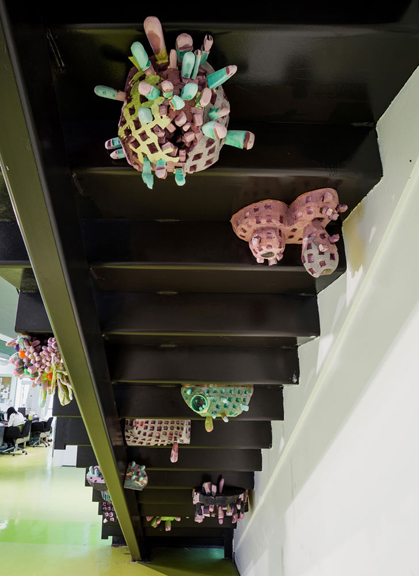
Nancy Lu Rosenheim
Swallow City #1-#21
21 sculptures adhere under the stairwell
2015
Polystyrene, resin, detritus, papier-mâché, chicken wire
Sizes range from 7”x15”x6” to 19”x25”x15
Photo credit: Tal Nisim
At the studio visit, you were working upon some new drawings and paintings. Can you share with us what you are presently investigating? Do you have any plans or exhibitions for the New Year?
I’m headed out to the Ragdale Residency in January, where I will be working on drawings for my new project, provisionally titled Ravishing | Ravaged: (inTOXICating Mutants from the New World Wilds). My premise will focus on the dis-eases and deformities that fowl manifest due to climate change and human error.
I think you saw some hybrid iterations of birds in my studio: vultures, the great blue heron and sandhill cranes. I’ve begun to crochet (thank you, youtube!) bird parts, for potential use in sculptural construction. Audubon books and prints at the Field Museum have been springboards. The rest is a mystery to me.
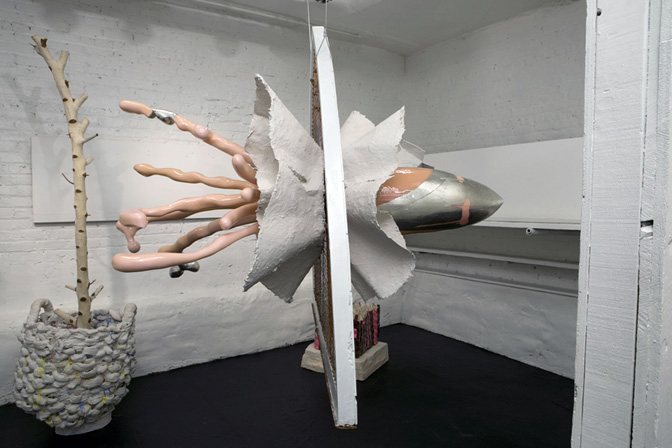
Nancy Lu Rosenheim
Bullet Skirt, from the project Carnal Animates, 2009
60”x60”x60″Polystyrene, gypsum product, found window frame, copper tubing, copper wire, aluminum leaf, resin
Photo credit: Clare Britt
For additional information on the work of Nancy Lu Rosenheim, please visit:
Nancy Lu Rosenheim – http://www.nancylurosenheim.com/
The Hyde Park Art Center – http://www.hydeparkart.org/exhibitions/nancy-lu-rosenheim-emswallow-cityem
Newcity – http://art.newcity.com/2015/06/15/portrait-of-the-artist-nancy-lu-rosenheim/
The Huffington Post – http://www.huffingtonpost.com/gail-hamburg/evidence-of-things-seen-the-art-of-nancy-lu-rosenheim_b_7683040.html
Fraser Taylor: The Shetland Drawings – http://nancylurosenheim.com/the-bike-room/fraser-taylor-shetland-drawings/
Interview by Chester Alamo-Costello


